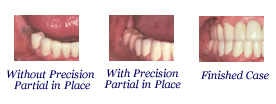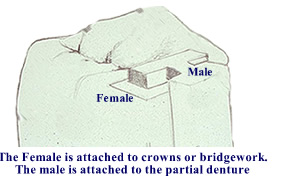What is a Precision Attachment Case?

A Precision Attachment Case uses precision attachments to connect a partial denture to fixed bridgework. Precision attachment partial dentures can be used to restore arches where there are not enough teeth for fixed bridgework.

What is a Precision Attachment?
 A precision attachment is a precision-machined male and female (key and lock) housing that connects a removable partial denture to fixed bridgework
A precision attachment is a precision-machined male and female (key and lock) housing that connects a removable partial denture to fixed bridgework
The female part of the attachment is soldered to fixed crowns or bridgework the male part is attached to the partial denture. The male is machined by the manufacturer to fit the female with such precision that any male out of the box will fit any female with an exact degree of accuracy. All of the precision attachments in a partial denture are positioned so that they are exactly parallel to each other.
What are the Advantages of Precision Attachment Cases?
Precision attachment partial dentures are the very best restorations where fixed restorations are contraindicated. Experience with more than 1000 cases during the last 50 years has uncovered several key advantages of this type of restoration:
- Cosmetic Appearance
- Maintainable Periodontal Health
- Longevity of Abutment Teeth
- Patient Comfort
- Questionable Teeth can be saved in a way that does not affect case
- Longevity if they are lost in the future.
- NaturalTooth and/or Implant Abutments can Be Used
- Precision Attachment Partial Dentures Can Be Adapted to Compensate
for Future Changes in the Mouth
There are many different kinds of attachments that will avoid the need for unsightly clasps, but only one type of precision attachment can claim has the greatest documentation when used according to basic principles of engineering. It was invented in 1906. When used properly, this type of precision attachment case will promote periodontal health and longevity of the abutments, prevent bone resorption of the ridges under the partial denture, and confer the highest degree of patient comfort.

Clinical documentation of cases since 1950 has proven that this type of case lasts longer than fixed bridgework!
How Does a Precision Partial Stay In Place?
Even though there are no locking mechanisms, a good precision attachment partial denture will not dislodge during normal function. The reason the partial denture does not continually fall out is because it is surveyed in two directions so that the path of insertion is different from the pull of the muscles and the action of the tongue and gravity. Although the partial cannot be dislodged during function, it can move in a vertical direction slightly to release the forces instead of passing along these forces to the abutment teeth. The result is physiologic stimulation of the abutment teeth and the edentulous ridges. Clinical experience has shown that this physiologic stimulation results in increased longevity of the abutment teeth4, even when a few teeth are required to carry the load of an entire arch. The stimulation of the edentulous ridge also prevents the bone resorption that typically reduces tissue support for the partial denture. The tissue under a well-fitting precision attachment partial is typically healthy and firm. There is surprisingly little wear of attachments that are used in this manner, even after many years of function! While the prosthesis may require relining or alteration of the occlusion to compensate for changes, it is rarely necessary to adjust or replace the male attachments on the partial.4 The partial is never kept in a glass overnight. It is worn 24 hours a day to prevent collapse of the musculature and the occlusion and only removed for hygiene.
What are the Requirements for Precision Attachment Partial Dentures?
The success of precision attachment partial dentures depends on creating an ideal architecture for the mouth. All the teeth that support bridgework are prepared with full shoulder preparations (flat ledges) in three-dimensions. In other words, the prepared teeth relate to each other, the gingiva (gums) and the underlying bone. Any defects must be corrected surgically in order to create health and the best architectural foundation to support dentistry. The dentistry must conform to sound principles of biomechanics that minimize forces on this foundation. These principles include narrow occlusal (biting surface) diameters, adequate room for hygiene, proper length and anatomy, solid and passive fit, and adequate occlusion (bite) at the correct jaw relationship. The importance of accurate impressions and models to the overall success of a precision attachment case cannot be over-emphasized. Precision attachments must be used in a precise manner in order to maintain a high percentage of longevity. Great care must be taken to ensure precision at every step; and steps cannot be skipped or the final result will be compromised. The entire chain can only be as strong as the weakest link. Precision attachment cases must fit with precision—the abutments must be stable and the frameworks must fit properly without rock.
